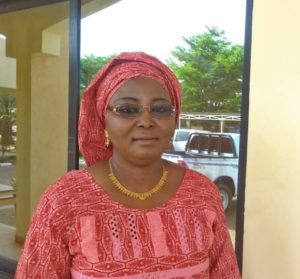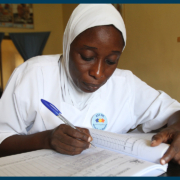Building Behavioral Design Skills: Conversations with Breakthrough ACTION Innovators
Written by: Finou Thérèse Mendy, ideas42
This is part of a series of conversations with members of the National Innovations Team (NIT), a group of 54 health professionals across government and non-profit sectors in Burkina Faso and Niger. NIT members engage in a hybrid online and in-person applied learning curriculum developed by ideas42, which includes an introduction to behavioral design and hands-on coaching from our behavioral economics experts.
Through the course, members develop and refine innovative solutions based on feedback from end users to address behavioral challenges across a range of health areas. The NIT was established in 2020 by Breakthrough ACTION, the U.S. Agency for International Development’s flagship SBC program.
This spotlight features Binta Soumana Gaoh, who is working within the postpartum family planning (PPFP) group in Niger to promote uptake of PPFP methods as part of the second cycle of the National Innovations Team (NIT) course in 2021–22. Binta also participated in the first cycle of the NIT activity, which focused on improving caregivers’ complementary feeding of infants aged six-eight months. In this interview, she discusses the effects of this training on her daily work as a communicator and as Head of the Communication Division at the Family Planning Directorate of the Ministry of Public Health of Niger.
What motivated you to participate in this training?
In the beginning, I thought it was just the usual two- or three-day training session and then everyone would go their separate ways. But when we went for the launch, the Breakthrough ACTION team explained the different modules—ideation, prototyping, user testing—and I thought, “Ah, this is what I need!” Especially because when we typically create behavior change communication materials, we have to hire designers and explain to them what we want. Then they go and make sketches and come back, and we usually tell them, “No, that’s not quite right,” and then they have to do another draft and come back to us. It’s a lot of back and forth. So, I thought to myself, if we knew how to do that work ourselves, it would go a lot faster.
In 2020, you participated in the first cycle of the NIT, which focused on developing innovations to increase adequate complementary feeding for infants. Why did you decide to come back again for this second cycle?
The first cycle was a learning process where I realized how much it helps to capture the attention of your target audience. That was innovative to me, because before that everything we designed really came from the West; all of our images and messages were not adapted to our context. But when we developed designs ourselves, we were able to consider our own culture and incorporate what is available in our country to reach our target audience. That really interested me.
For the second cycle, now that we were equipped with the skills from cycle one, I advocated for a theme on family planning, because that’s what I focus on. We recently set up a new department, but we don’t have enough behavior change materials. I convinced Breakthrough ACTION to select postpartum family planning (PPFP) as one of the four focus behaviors of this second cycle by making the case that with the designs that we will develop, I can mobilize partners to reproduce and scale them up on the ground.
What are you working on in this second cycle?
The facilitators understood and accepted the theme of PPFP because it is part of the high-impact interventions that we are scaling up, especially since here in Niger, there are a lot of barriers to PPFP. For example, it is the man who decides everything, including reproductive health and the woman’s health. We’ve already generated more than 200 ideas and synthesized the different features of our designs. Now we are working on a dialogue tool that will help a woman and her husband choose a specific moment to talk to a health provider about FP, select a preferred method, and identify the exact moment when they will start using it. The dialogue starts at prenatal consultation and continues through delivery, so the couple can decide on their preferred method before the birth of their child. Then, immediately after the woman delivers, she can start using her preferred method.
“Before, everything we designed really came from the West; all our images and messages were not adapted to our context. But when we developed designs ourselves, we were able to consider our own culture and what is available in our country”
Was there anything you learned from the course that was different from your regular way of working?
By participating in the NIT, we learned how to transform our own ideas into behaviorally informed communication materials and interventions. Before the NIT, I had never developed a design myself. With the NIT, I learned that I could design on my own. Maybe my sketch isn’t well done, and the illustrator will fix it when he sees it, but it’s what I want that’s in the document. That’s new! And there’s also the user testing. Here, we don’t always pre-test our designs. Sometimes we rely on the image—it’s beautiful—and the writing is good. If we understand, we think that the others will understand too, and we just go ahead and implement it. Now, with the NIT, we’ve learned that we really should be doing internal user tests, where other colleagues give us feedback on the designs, and then we should go to the target population to get their opinion. That allows us to investigate whether our design and the messages we are expressing through it are presented in a way that users really understand.
To what extent did user testing improve the designs your team developed?
When we did it during the first cycle, we presented our design to our colleagues and they said, “Yes, this is good, when you see this, you understand.” And clearly, we saw all the steps. But, when we went out into the field to user test it with our target audience, we presented it to women who had never been to school, and they told us, “No, this doesn’t mean that, here you should have done that. This part goes on this side, and it’s such and such an image that should be used.” We were so astonished that women who hadn’t been to school were giving us this really relevant feedback that our colleagues back at the office with their advanced degrees hadn’t seen or thought useful. Our big takeaway from that was that gathering feedback from your target audience is always very important.
“We were so astonished that women who hadn’t been to school were giving us this really relevant feedback that our colleagues back at the office with their advanced degrees hadn’t seen or thought useful.”
How has being a part of the National Innovations Team changed the way you do your work?
Even our colleagues in the office who are not part of the NIT have been influenced by it, because sometimes when we are going through the course lectures, we’ll do a debriefing with them to share what we’re learning. Also, when we were creating our designs for this cycle and last cycle, they would walk by and notice and ask us what it’s about. So, we would explain it to them and many of them became really interested in the NIT, but they just didn’t have the chance to enroll. Maybe they’ll have another chance next year? Overall, I’d say being a part of the NIT has allowed us to rethink the way we do our work and to improve it.

 Curt Carnemark/World Bank
Curt Carnemark/World Bank
 Cambey Mikush/Photoshare
Cambey Mikush/Photoshare Sara Holbak/VectorWorks/Photoshare
Sara Holbak/VectorWorks/Photoshare Sarah Hoibak/VectorWorks/Photoshare
Sarah Hoibak/VectorWorks/Photoshare Getty Images/Image of Empowerment
Getty Images/Image of Empowerment
 © 2012 CCP/NURHI 2, Courtesy of Photoshare
© 2012 CCP/NURHI 2, Courtesy of Photoshare